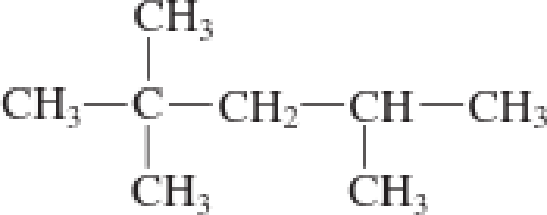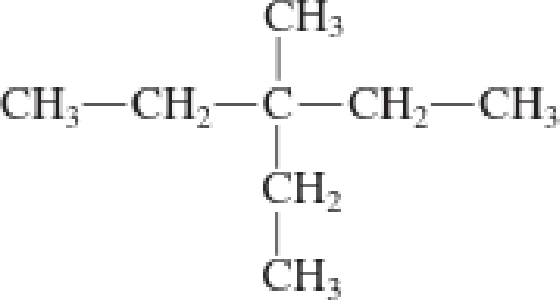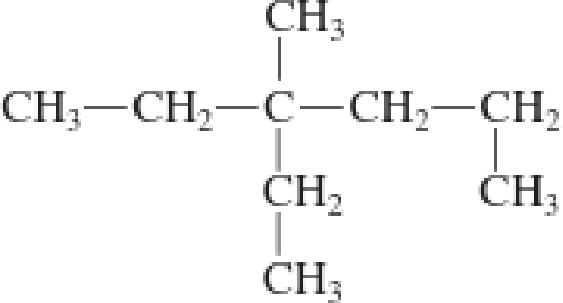
Organic And Biological Chemistry
7th Edition
ISBN: 9781305081079
Author: STOKER, H. Stephen (howard Stephen)
Publisher: Cengage Learning,
expand_more
expand_more
format_list_bulleted
Concept explainers
Textbook Question
Chapter 1, Problem 1.75EP
For each of the
a. 
b. 
c. 
d. 
Expert Solution & Answer
Trending nowThis is a popular solution!

Students have asked these similar questions
true or false, Gibbs Free Energy is the measure of randomness of a system
true or false, enthalpy determines whether a reaction in endothermic or exothermic
Check
Consider the
13 C NMR spectrum below.
140
120
100
80
60
60
PPM
40
20
0
The spectrum belongs to which one of the following constitutional isomers of the compound C 10H14? Select the single best answer.
✓
Save
© 2025 McGraw Hill LLC. All Rights Reserved.
Chapter 1 Solutions
Organic And Biological Chemistry
Ch. 1.1 - Prob. 1QQCh. 1.1 - Prob. 2QQCh. 1.2 - Which of the following statements about the...Ch. 1.2 - Prob. 2QQCh. 1.3 - Prob. 1QQCh. 1.3 - Prob. 2QQCh. 1.4 - Prob. 1QQCh. 1.4 - Prob. 2QQCh. 1.4 - Prob. 3QQCh. 1.5 - Prob. 1QQ
Ch. 1.5 - Prob. 2QQCh. 1.5 - Prob. 3QQCh. 1.6 - Prob. 1QQCh. 1.6 - Prob. 2QQCh. 1.6 - Prob. 3QQCh. 1.6 - Prob. 4QQCh. 1.7 - Prob. 1QQCh. 1.7 - Prob. 2QQCh. 1.8 - Prob. 1QQCh. 1.8 - Prob. 2QQCh. 1.8 - Prob. 3QQCh. 1.8 - Prob. 4QQCh. 1.8 - Prob. 5QQCh. 1.8 - Prob. 6QQCh. 1.8 - Prob. 7QQCh. 1.9 - Prob. 1QQCh. 1.9 - Prob. 2QQCh. 1.10 - Prob. 1QQCh. 1.10 - Prob. 2QQCh. 1.11 - Prob. 1QQCh. 1.11 - Prob. 2QQCh. 1.11 - Prob. 3QQCh. 1.12 - Prob. 1QQCh. 1.12 - Prob. 2QQCh. 1.12 - Prob. 3QQCh. 1.13 - Prob. 1QQCh. 1.13 - Prob. 2QQCh. 1.13 - Prob. 3QQCh. 1.14 - Prob. 1QQCh. 1.14 - Prob. 2QQCh. 1.14 - Prob. 3QQCh. 1.15 - Prob. 1QQCh. 1.15 - Prob. 2QQCh. 1.16 - Prob. 1QQCh. 1.16 - Prob. 2QQCh. 1.16 - Prob. 3QQCh. 1.17 - Prob. 1QQCh. 1.17 - Prob. 2QQCh. 1.17 - Prob. 3QQCh. 1.17 - Prob. 4QQCh. 1.18 - Prob. 1QQCh. 1.18 - Prob. 2QQCh. 1.18 - Prob. 3QQCh. 1.18 - Prob. 4QQCh. 1 - Prob. 1.1EPCh. 1 - Prob. 1.2EPCh. 1 - Prob. 1.3EPCh. 1 - Prob. 1.4EPCh. 1 - Indicate whether each of the following situations...Ch. 1 - Indicate whether each of the following situations...Ch. 1 - Prob. 1.7EPCh. 1 - Prob. 1.8EPCh. 1 - What is the difference between a saturated...Ch. 1 - What structural feature is present in an...Ch. 1 - Prob. 1.11EPCh. 1 - Prob. 1.12EPCh. 1 - Prob. 1.13EPCh. 1 - Prob. 1.14EPCh. 1 - Prob. 1.15EPCh. 1 - Prob. 1.16EPCh. 1 - Convert the expanded structural formulas in...Ch. 1 - Prob. 1.18EPCh. 1 - Prob. 1.19EPCh. 1 - Prob. 1.20EPCh. 1 - Prob. 1.21EPCh. 1 - Prob. 1.22EPCh. 1 - Prob. 1.23EPCh. 1 - Prob. 1.24EPCh. 1 - Prob. 1.25EPCh. 1 - Prob. 1.26EPCh. 1 - Indicate whether each of the following would be...Ch. 1 - Indicate whether each of the following would be...Ch. 1 - Prob. 1.29EPCh. 1 - Explain why two different straight-chain alkanes...Ch. 1 - With the help of Table 12-1, indicate how many...Ch. 1 - Prob. 1.32EPCh. 1 - How many of the numerous eight-carbon alkane...Ch. 1 - How many of the numerous seven-carbon alkane...Ch. 1 - For each of the following pairs of structures,...Ch. 1 - For each of the following pairs of structures,...Ch. 1 - Convert each of the following linear condensed...Ch. 1 - Prob. 1.38EPCh. 1 - Prob. 1.39EPCh. 1 - Prob. 1.40EPCh. 1 - Prob. 1.41EPCh. 1 - Prob. 1.42EPCh. 1 - Prob. 1.43EPCh. 1 - Prob. 1.44EPCh. 1 - Prob. 1.45EPCh. 1 - Prob. 1.46EPCh. 1 - Prob. 1.47EPCh. 1 - Prob. 1.48EPCh. 1 - Prob. 1.49EPCh. 1 - Prob. 1.50EPCh. 1 - Prob. 1.51EPCh. 1 - Prob. 1.52EPCh. 1 - Draw a condensed structural formula for each of...Ch. 1 - Draw a condensed structural formula for each of...Ch. 1 - Prob. 1.55EPCh. 1 - For each of the alkanes in Problem 12-54,...Ch. 1 - Explain why the name given for each of the...Ch. 1 - Prob. 1.58EPCh. 1 - Indicate whether or not the two alkanes in each of...Ch. 1 - Prob. 1.60EPCh. 1 - How many of the 18 C8 alkane constitutional...Ch. 1 - How many of the nine C7 alkane constitutional...Ch. 1 - Prob. 1.63EPCh. 1 - Prob. 1.64EPCh. 1 - Prob. 1.65EPCh. 1 - Prob. 1.66EPCh. 1 - Do the line-angle structural formulas in each of...Ch. 1 - Do the line-angle structural formulas in each of...Ch. 1 - Convert each of the condensed structural formulas...Ch. 1 - Convert each of the condensed structural formulas...Ch. 1 - Assign an IUPAC name to each of the compounds in...Ch. 1 - Prob. 1.72EPCh. 1 - Prob. 1.73EPCh. 1 - Prob. 1.74EPCh. 1 - For each of the alkane structures in Problem...Ch. 1 - For each of the alkane structures in Problem...Ch. 1 - Prob. 1.77EPCh. 1 - Prob. 1.78EPCh. 1 - Prob. 1.79EPCh. 1 - Prob. 1.80EPCh. 1 - Prob. 1.81EPCh. 1 - Prob. 1.82EPCh. 1 - Draw condensed structural formulas for the...Ch. 1 - Draw condensed structural formulas for the...Ch. 1 - To which carbon atoms in a hexane molecule can...Ch. 1 - Prob. 1.86EPCh. 1 - Prob. 1.87EPCh. 1 - Prob. 1.88EPCh. 1 - Give an acceptable alternate name for each of the...Ch. 1 - Prob. 1.90EPCh. 1 - Prob. 1.91EPCh. 1 - Prob. 1.92EPCh. 1 - Prob. 1.93EPCh. 1 - Prob. 1.94EPCh. 1 - What is the molecular formula for each of the...Ch. 1 - Prob. 1.96EPCh. 1 - Prob. 1.97EPCh. 1 - Prob. 1.98EPCh. 1 - Prob. 1.99EPCh. 1 - How many secondary carbon atoms are present in...Ch. 1 - Assign an IUPAC name to each of the following...Ch. 1 - Assign an IUPAC name to each of the following...Ch. 1 - Prob. 1.103EPCh. 1 - Prob. 1.104EPCh. 1 - Prob. 1.105EPCh. 1 - Prob. 1.106EPCh. 1 - What is the molecular formula for each of the...Ch. 1 - Prob. 1.108EPCh. 1 - Prob. 1.109EPCh. 1 - Prob. 1.110EPCh. 1 - Prob. 1.111EPCh. 1 - Prob. 1.112EPCh. 1 - Determine whether cistrans isomerism is possible...Ch. 1 - Prob. 1.114EPCh. 1 - Prob. 1.115EPCh. 1 - Prob. 1.116EPCh. 1 - Prob. 1.117EPCh. 1 - Indicate whether the members of each of the...Ch. 1 - Prob. 1.119EPCh. 1 - Prob. 1.120EPCh. 1 - Prob. 1.121EPCh. 1 - Prob. 1.122EPCh. 1 - Prob. 1.123EPCh. 1 - Which member in each of the following pairs of...Ch. 1 - Prob. 1.125EPCh. 1 - Prob. 1.126EPCh. 1 - Answer the following questions about the...Ch. 1 - Prob. 1.128EPCh. 1 - Prob. 1.129EPCh. 1 - Prob. 1.130EPCh. 1 - Write molecular formulas for all the possible...Ch. 1 - Write molecular formulas for all the possible...Ch. 1 - Prob. 1.133EPCh. 1 - Prob. 1.134EPCh. 1 - Prob. 1.135EPCh. 1 - Assign an IUPAC name to each of the following...Ch. 1 - Prob. 1.137EPCh. 1 - Prob. 1.138EPCh. 1 - Prob. 1.139EPCh. 1 - Prob. 1.140EPCh. 1 - Prob. 1.141EPCh. 1 - Prob. 1.142EPCh. 1 - Prob. 1.143EPCh. 1 - Prob. 1.144EPCh. 1 - Prob. 1.145EPCh. 1 - Prob. 1.146EPCh. 1 - Give the IUPAC names for the eight isomeric...Ch. 1 - Prob. 1.148EP
Knowledge Booster
Learn more about
Need a deep-dive on the concept behind this application? Look no further. Learn more about this topic, chemistry and related others by exploring similar questions and additional content below.Similar questions
- The structure of compound 1,1,2-trichloropropane is given below. Cl Cl Cl 1 How many signals would you expect to find in the 'H NMR spectrum of 1,1,2-trichloropropane? ×arrow_forward1, How many signals do you expect in the H NMR spectrum for this molecule? Write the answer below. Also, in each of the drawing areas below is a copy of the molecule, with Hs shown. In each copy, one of the H atoms is colored red. Highlight in red all other H atoms that would contribute to the same signal as the H already highlighted red. Note for advanced students: In this question, any multiplet is counted as one signal. Number of signals in the 'H NMR spectrum. For the molecule in the top drawing area, highlight in red any other H atoms that will contribute to the same signal as the H atom already highlighted red. If no other H atoms will contribute, check the box at right. No additional Hs to color in top molecule For the molecule in the bottom drawing area, highlight in red any other H atoms that will contribute. to the same signal as the H atom already highlighted red. If no other H atoms will contribute, check the box at right. No additional Hs to color in bottom molecule Check…arrow_forwardIncorrect Row 2: Your answer is incorrect. Consider this molecule: How many H atoms are in this molecule? 22 How many different signals could be found in its 'H NMR spectrum? 12 Note: A multiplet is considered one signal.arrow_forward
- 13 How many signals would you expect to see in the Check O signal(s) X § 'C NMR spectrum for the following compound? © 2025 McGraw Hillarrow_forward13 Consider the "C NMR spectrum below. 140 120 100 80 60 40 20 20 PPM 0 The spectrum belongs to which one of the following constitutional isomers of the compound C,H12? Select the single best answer. Check ✓ G Save For Later 2025 McGraw Hill LLC. All Rights Reserved. Terms of Usearrow_forwardThe structure of compound 1,3,5-trimethylbenzene (mesitylene) is given below. How many signals would you expect to find in the 'H NMR spectrum of 1,3,5-trimethylbenzene (mesitylene)? Check ×arrow_forward
- 1 How many signals do you expect in the 'H NMR spectrum for this molecule? CI CI Cl Write the answer in the table below. Also, in each of the drawing areas below is a copy of the molecule, with H atoms shown. In each copy, one of the H atoms is highlighted red. Highlight in red all other H atoms that would contribute to the same signal as the H already highlighted red. Note for advanced students: Remember, a multiplet is considered one signal in the 'H NMR spectrum. 1 Number of signals in the 'H NMR spectrum. ☐ For the molecule in the top drawing area, highlight in red any other H atoms that will contribute to the same signal as the H atom already highlighted red. If no other H atoms will contribute, check the box at right. No additional H atoms to highlight in top molecule For the molecule in the bottom drawing area, highlight in red any other H atoms that will contribute to the same signal as the H atom already highlighted red. If no other H atoms will contribute, check the box at…arrow_forwardwrtie the balanced equation and find the E° when the following half- reactions are combined Zn2+(aq) + 2e---> Zn(s) E°= -0.763V Ag+(aq) + e---> Ag (s) E°=+0.799Varrow_forwardConsider this molecule: How many H atoms are in this molecule? How many different signals could be found in its 'H NMR spectrum? Note: A multiplet is considered one signal. ☐arrow_forward
- Study this 'H NMR spectrum, and then answer the questions about it in the table below. Check 1.0- 0.5- 0.0 10.0 9.0 8.0 7.0 6.0 5.0 4.0 3.0 2.0 1.0 0.0 What unit symbol should be written on the horizontal axis? What is the chemical shift & of the doublet? If there is no doublet, just check the box instead. Give your answer to 2 significant digits. What is the chemical shift of the signal immediately upfield of the doublet? If there is no doublet, or no signal upfield of it, check the box instead. What is the chemical shift & of the least deshielded proton? If you can't tell without more information, check the box instead. 血 8 = ☐ There is no doublet. 8 = ☐ No such signal. 8 = 0 Need more information.arrow_forwardhow many moles of H2O2 are required to react with 11g of N2H4 according to the following reaction? (atomic weights: N=14.01, H=1.008, O= 16.00) 7H2O2 + N2H4 -> 2HNO3 + 8H20arrow_forwardcalculate the number of moles of H2 produced from 0.78 moles of Ga and 1.92 moles HCL? 2Ga+6HCL->2GaCl3+3H2arrow_forward
arrow_back_ios
SEE MORE QUESTIONS
arrow_forward_ios
Recommended textbooks for you
 Organic And Biological ChemistryChemistryISBN:9781305081079Author:STOKER, H. Stephen (howard Stephen)Publisher:Cengage Learning,
Organic And Biological ChemistryChemistryISBN:9781305081079Author:STOKER, H. Stephen (howard Stephen)Publisher:Cengage Learning, General, Organic, and Biological ChemistryChemistryISBN:9781285853918Author:H. Stephen StokerPublisher:Cengage Learning
General, Organic, and Biological ChemistryChemistryISBN:9781285853918Author:H. Stephen StokerPublisher:Cengage Learning
 Introduction to General, Organic and BiochemistryChemistryISBN:9781285869759Author:Frederick A. Bettelheim, William H. Brown, Mary K. Campbell, Shawn O. Farrell, Omar TorresPublisher:Cengage Learning
Introduction to General, Organic and BiochemistryChemistryISBN:9781285869759Author:Frederick A. Bettelheim, William H. Brown, Mary K. Campbell, Shawn O. Farrell, Omar TorresPublisher:Cengage Learning Chemistry: The Molecular ScienceChemistryISBN:9781285199047Author:John W. Moore, Conrad L. StanitskiPublisher:Cengage Learning
Chemistry: The Molecular ScienceChemistryISBN:9781285199047Author:John W. Moore, Conrad L. StanitskiPublisher:Cengage Learning Introductory Chemistry: An Active Learning Approa...ChemistryISBN:9781305079250Author:Mark S. Cracolice, Ed PetersPublisher:Cengage Learning
Introductory Chemistry: An Active Learning Approa...ChemistryISBN:9781305079250Author:Mark S. Cracolice, Ed PetersPublisher:Cengage Learning

Organic And Biological Chemistry
Chemistry
ISBN:9781305081079
Author:STOKER, H. Stephen (howard Stephen)
Publisher:Cengage Learning,

General, Organic, and Biological Chemistry
Chemistry
ISBN:9781285853918
Author:H. Stephen Stoker
Publisher:Cengage Learning


Introduction to General, Organic and Biochemistry
Chemistry
ISBN:9781285869759
Author:Frederick A. Bettelheim, William H. Brown, Mary K. Campbell, Shawn O. Farrell, Omar Torres
Publisher:Cengage Learning

Chemistry: The Molecular Science
Chemistry
ISBN:9781285199047
Author:John W. Moore, Conrad L. Stanitski
Publisher:Cengage Learning

Introductory Chemistry: An Active Learning Approa...
Chemistry
ISBN:9781305079250
Author:Mark S. Cracolice, Ed Peters
Publisher:Cengage Learning
Chapter 4 Alkanes and Cycloalkanes Lesson 2; Author: Linda Hanson;https://www.youtube.com/watch?v=AL_CM_Btef4;License: Standard YouTube License, CC-BY
Chapter 4 Alkanes and Cycloalkanes Lesson 1; Author: Linda Hanson;https://www.youtube.com/watch?v=PPIa6EHJMJw;License: Standard Youtube License